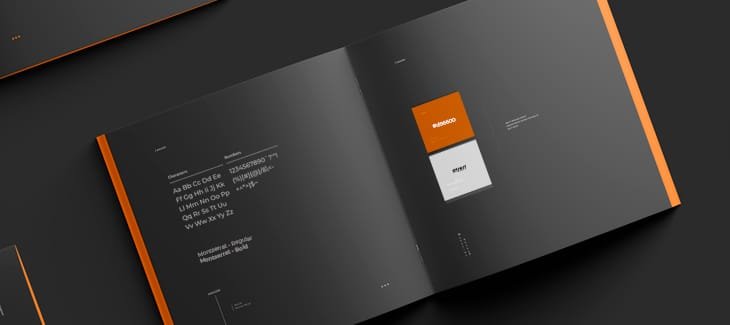Branding is a system that helps a business become recognizable, build trust, and create the necessary associations among customers. The main tool for achieving this is the brandbook. If you’ve already considered creating an identity, it is time to understand what the brandbook is and why do you need it.

What is the brandbook, and why do businesses need it?
The brandbook is a kind of a brand’s “passport.” It contains all the visual and conceptual elements that make up a company’s corporate identity. It answers the key question: what should the brand look like to be recognized at first glance?
Why do you need the brandbook? This document serves several purposes:
- Ensures a brand always looks consistent – on social media, packaging, and advertisements.
- Helps designers, marketers, or partners understand how to use logos, colors, fonts, and other brand identity elements.
- Maintains the integrity and strength of the brand’s visual image.
Simply put, the brandbook ensures the brand has clear rules, not creative chaos. It’s a guide on how the brand should look like, sound, and behave in various situations.
The brandbook’s essence and content: a checklist for business
What does the brandbook include? Here’s a basic but highly helpful checklist that can be adapted for any project:
- Logo & emblem – primary and secondary versions, usage rules, and restrictions (e.g., no stretching, no color changes).
- Fonts – primary and secondary fonts for headings, body text, overlays, and digital materials.
- Color palette – primary and secondary colors, and codes for digital and print (CMYK, RGB, HEX).
- Avatars & badges – for social media, messengers, marketplaces, and email signatures.
- Brand character – visual style, illustrations, tone of voice, and behavior.
- Slogan – a tagline that reflects the brand’s essence.
- Icons – styling and ready-made elements for websites, apps, and interfaces.
- Stickers – designs for branded stickers (digital and print).
- Packaging – mockups for product packaging and offline materials.
- Watermark – a visual element to protect branded images and content.
- QR Code – design and usage rules adapted to the brand style.
- Corporate sound – a jingle, melody, or sound for videos, ads, and calls.
- Stationery & documents – templates for contracts, letters, presentations, and headers.
- Company presentation – a multi-purpose PDF-presentation about the company, products, and services.
- Video presentation – a short clip reflecting the brand’s mission and personality.
- Corporate merchandise – flags, stands, signs, badges, photo cards, etc.
- Business cards – design, templates, and adaptation rules for employees.
- Signage (indoor & outdoor) – must align with the corporate style.
- Vehicle branding – layouts for a logo and info placement on vehicles.
- Composition rules – element combinations, spacing, proportions, and usage order.
This list is a basis, not a limit. The brandbook’s scope and content depend on the business type, growth strategy, budget, and other factors. Some cases may also include brand voice, visual storytelling principles, photo style, and layout guidelines.
What should the brandbook include?
Regardless of business size or niche, key components are essential as the brandbook loses its purpose without them:
- Logo and rules for its use across different products.
- Fonts and color palette.
- Brand identity components (icons, patterns, stickers, and watermark).
- Use examples.
The goal of a corporate identity is both to look attractive and be recognizable. If the logo and colors change once a month, brand trust erodes.
How to create the effective brandbook?
Creating the brandbook on your own is a challenging task, especially if you want it to work for your business, rather than just hang there as a beautiful PDF-file.
Key considerations:
- Logo design must account for scalability, color combinations, and industry style.
- Colors should align with visual preferences and psychological impact.
- Fonts must match the brand’s mood and should not be random choices.
- All elements should unite under a single concept.
Every identity element should align with the brand’s core idea, visual style, and tone to ensure consistency across all touchpoints. Final assets should be in multiple formats – digital (PNG, SVG, WebP for websites/social media) and print (AI, EPS, PDF, TIFF in CMYK). Versions for different backgrounds, inversions, compact logos, and favicons are also crucial for multi-purpose use.
The easiest way is to trust the experts. At the DMark digital marketing agency, we create brand identities and brandbooks that aren’t just polished – they drive recognition, trust, and growth. We tailor visuals to your niche and document guidelines so every team member (from SMM managers to printers) can apply them seamlessly.
Bottom line
What does the brandbook include? Far more than meets the eye. It’s not just a logo but a system of visual and conceptual pillars – a tool for scaling your business and maintaining a strong image.
If you’re looking for a team to create the brandbook from scratch or refine an existing one, DMark will guide and support you at every step. Together, we’ll define the optimal scope, and then perfect every detail. Contact us, and we’ll analyze your brand – point by point.
